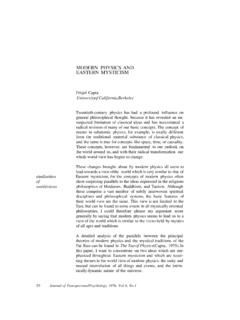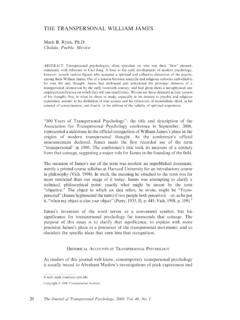Transcription of THE PERENNIAL PHILOSOPHY REVISITED
1 THE PERENNIAL PHILOSOPHY REVISITED . Jorge N. Ferrer Berkeley, California ABSTRACT:This essay critically examines the perennialist metaphysic endorsed in most transpersonal works. After a historic overview of the idea of a PERENNIAL PHILOSOPHY , the modern debate between peren- nialist and contextualist scholars in the study of mysticism is briefly reviewed. It is suggested that the PERENNIAL vision stems from an a priori commitment to a nondual monistic metaphysics, is hostage of objectivism and essentialism, and is prone to dogmatism and intolerance. The author then shows that perennialism and contextualism share certain complementary Cartesian-Kantian assumptions that force spirituality into limiting molds, and concludes suggesting the need for a vision of human spirituality that integrates the merits of perennialism and contexnralism while eschewing their shortcomings.
2 Transpersonal studies are usually characterized as disciplines independent of any par- ticular religious tradition, philosophical school, or world view ( , Walsh & Vaughan, 1993). However, the philosophical foundations of transpersonal theory have generally been associated with the PERENNIAL PHILOSOPHY ( , Hutchins, 1987; Rothberg, 1986;. Valle, 1989; Wilber, 1990, 1995), and the spiritual universalism typical of perennialism pervades both early and modem transpersonal scholarship ( , Grof, 1988, 1998;. Harman, 1988; Maslow, 1970; Vaughan, 1982; Wilber, 1977, 1995; Wittine, 1989). According to Wilber (1994), for example, "the aim of transpersonal psychology .. is to give a psychological presentation of the PERENNIAL PHILOSOPHY and the Great Chain of Being" (p.)
3 X). Vaughan (1982), one of the leaders of the transpersonal movement, also asserts that the transpersonal perspective "has its roots in the ancient PERENNIAL philos- ophy" (p. 38), and "recognizes the transcendental unity of all religions and sees the unity in the mystical core of every spiritual tradition" (p. 37). Likewise, whereas Hutchins (1987) presents transpersonal psychology as a contemporary exploration of the PERENNIAL PHILOSOPHY , Wittine (1989) defines transpersonal psychotherapy as "an approach to healing/growth that aims to bridge the Western psychological tradition .. and the world's PERENNIAL PHILOSOPHY " (p. 269). And one of the main goals of Grof's (1998) latest work is to show that "modem consciousness research has generated important data that support the basic tenets of the PERENNIAL PHILOSOPHY " (p.
4 3). Only in recent years have a few transpersonal authors begun to recognize the tacit nature of this association between transpersonal theory and the PERENNIAL PHILOSOPHY . I thank Steve Dinan. John Heron, Kaisa Puhakka, Kenneth Ring, Larry Spiro, Richard Tamas, and Michael Washburn for their constructive comments on earlier versionsof thls essay. to: Jorge N. Ferrer,California Institute of Integral Studies, 1453 Mission Street, San Francisco. CA 94103. Copyright 2000 TranspersonalInstitute The Journal of Transpersonal Psychology. 2000, Vol. 32, 7. Discussing the assumptions of current transpersonal definitions, for example, Walsh and Vaughan (1993) write: "Exploring the precise relationship between transper- sonal psychology and the PERENNIAL PHILOSOPHY is an important task for future research, but assuming the nature of the relationship in current definitions may be premature" (p.
5 201). In this spirit, the main objectiveof this essay is to critically examine the adhesion of transpersonaltheory to a ,I offera historicaloverviewof the idea of a perennialphilosophyand a typologyof the main varietiesof perennialism. Second,I briefly reviewthe contemporarydebate betweencontextualistand PERENNIAL - ist scholarsin the modem study on , I discuss severalfundamentaldif- ficultiesshared by all varietiesof perennialism,Finally,I unpack a set of complemen- tary epistemologicalassumptionsthat constrain both perennialism and contextualism, and I suggest the need for a vision of human spirituality that integrates their valid insights while eschewingtheir shortcomings. THEIDEAOFA PERENNIALPHILOSOPHY. The idea of a PERENNIAL PHILOSOPHY (philosophiaperennis) has received differentartic- ulations throughoutthe history of search for a universal,per- manent, and all-encompassing philosophycan be traced to the Neoplatonismof Philo of Alexandria or the Platonic-Christiansynthesis of St.
6 Augustine. However,it is not until the Renaissancethat we find the term " PERENNIAL PHILOSOPHY " explicitly used in philosophical circles (Loemker, 1973). More precisely, it was Agostino Steuco (1497-1546), bishop of Kisamos and librarian of the Vatican,who coined this term to refer to the prisca theologiaor philosophiapriscorium of MarsilioFicino,a unifying philosophical system based on a synthesis of Platonic principles and Christian doc- , the modem notion of a PERENNIAL PHILOSOPHY shouldbe regardedas a prod- uct of the ecumenicalinterestof the Christiantraditionin the NeoplatonicRenaissance (Marsilio Ficino, Giovanni Pico della Mirandola, Nicolas de Cusa, Agostino Steuco, etc.) in finding unity and harmony amidst a multiplicity of conflicting world views (Schmitt, 1966).
7 Throughout the history of PHILOSOPHY ,the term " PERENNIAL PHILOSOPHY " tphilosophia perennis) was also used as a synonymfor ScholasticismandThomism;as the final goal of PHILOSOPHY by Leibniz; as the regulativeideal of philosophicalpractice by Jaspers;. and as a world PHILOSOPHY , synthesis of East and West, by Radhakrishnan (Collins, 1962; Loemker, 1973).Common to all these conceptions,however,is the idea that a philosophicalcurrent exists that has endured through centuries,and that is able to inte- grate harmoniouslyall traditionsin terms of a single Truththat underlies the apparent plurality of world to the defenders of the PERENNIAL plrilosophy,this unity in human knowledgestemsfrom the existenceof a single ultimaterealitythat can be apprehendedby the human intellect under certain special conditions.
8 Although already reintroduced in the West first by Madame Blavatsky and the TheosophicalSociety founded in 1875, and later by Swami Vivekanandain his influ- ential address to the World's Parliamentof Religionsheld in Chicago in 1893 (Clarke, 1997; Faivre, 1994), it was not until thepublication of Aldous Huxley's (1945) The 8 TheJournalof Transpersonal Psychology,2000, , PERENNIAL PHILOSOPHY that perennialist ideas reachedthe masses and became popular beyond esotericand is well known, Huxley (1945) describedthe perennialphilosophyas "the metaphysicsthat recognizesa divine Reality substantial to the world of thingsand lives and minds;the psychologythat finds in the soul some- thingsimilarto, or even identicalwith, divineReality;the ethic thatplacesman's final end in the knowledgeof the immanentand transcendentGroundof all being" (p, vii).
9 What characterizesHuxley's perennialism,as well as the one of the so-calledtradi- tionalistssuch as Rene Guenon,Ananda K. Coomaraswamy,or Frithjof Schuon (see Quinn, 1997),is the conviction that the "singleTruth"of the PERENNIAL PHILOSOPHY can be found at the heart of the mystical teachings of the world's religious traditions. Although with differentemphases,all these authors claim that whereas the exoteric beliefsof the religioustraditionsare assortedand at timesevenincompatible,theireso- tericor mystical dimension reveals an essential unitythat transcends this doctrinal plu- is so, traditionalists argue,because mystics of all ages andplacescan tran- scend the different conceptual schemes provided by their cultures,languages,and doc- trines and consequently access a direct intuitive understandingof reality (gnosis).
10 Therefore,perennialists generally distinguish between mystical experience,which is universal and timeless,and its interpretation,whichis culturally and historically deter- mined. According to this view,the samemystical experience of the nondual Ground of Being would be interpreted as emptiness (sunyata) by a Mahayana Buddhist, as Brahman by anAdvaitaVedantin, as the union with God by a Christian, or as an object- less absorption iasamprajnatasamadhiy by a practitioner of Patafijali'syoga. In all cases,the experience is the same,the interpretation different. But what is this "single Truth" about which all contemplative traditionssupposedly converge?Accordingto modern defenders of the mystical version of the PERENNIAL phi- losophy,such as Nasr (1989, 1993),Schuon (1984a),and Smith (1976, 1987, 1989), the doctrinalcore of the perennialphilosophy is the belief that Absolute Spirit, Pure Consciousness,or the Universal Mind, is the fundamentalessence of both human nature and the totalityof there may be some descriptive or interpre- tive divergences, all contemplative traditions regard reality as originated by, and onto- logically the same as, a simultaneously immanent and transcending Spiritthat is iden- tical in essenceto human innermost Spirit constitutes the ultimate referentfor what can be regardedas real, true, and valuable.







